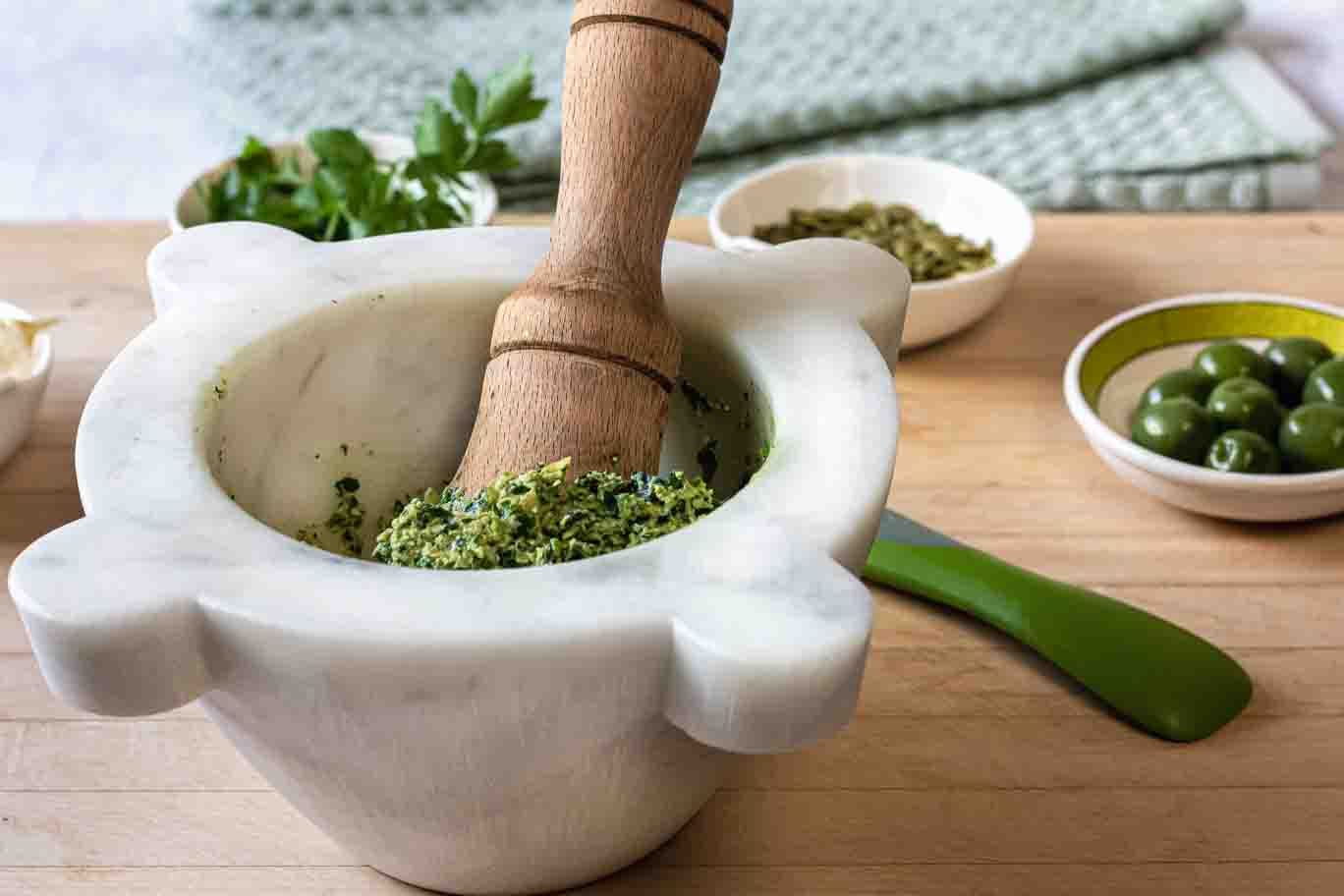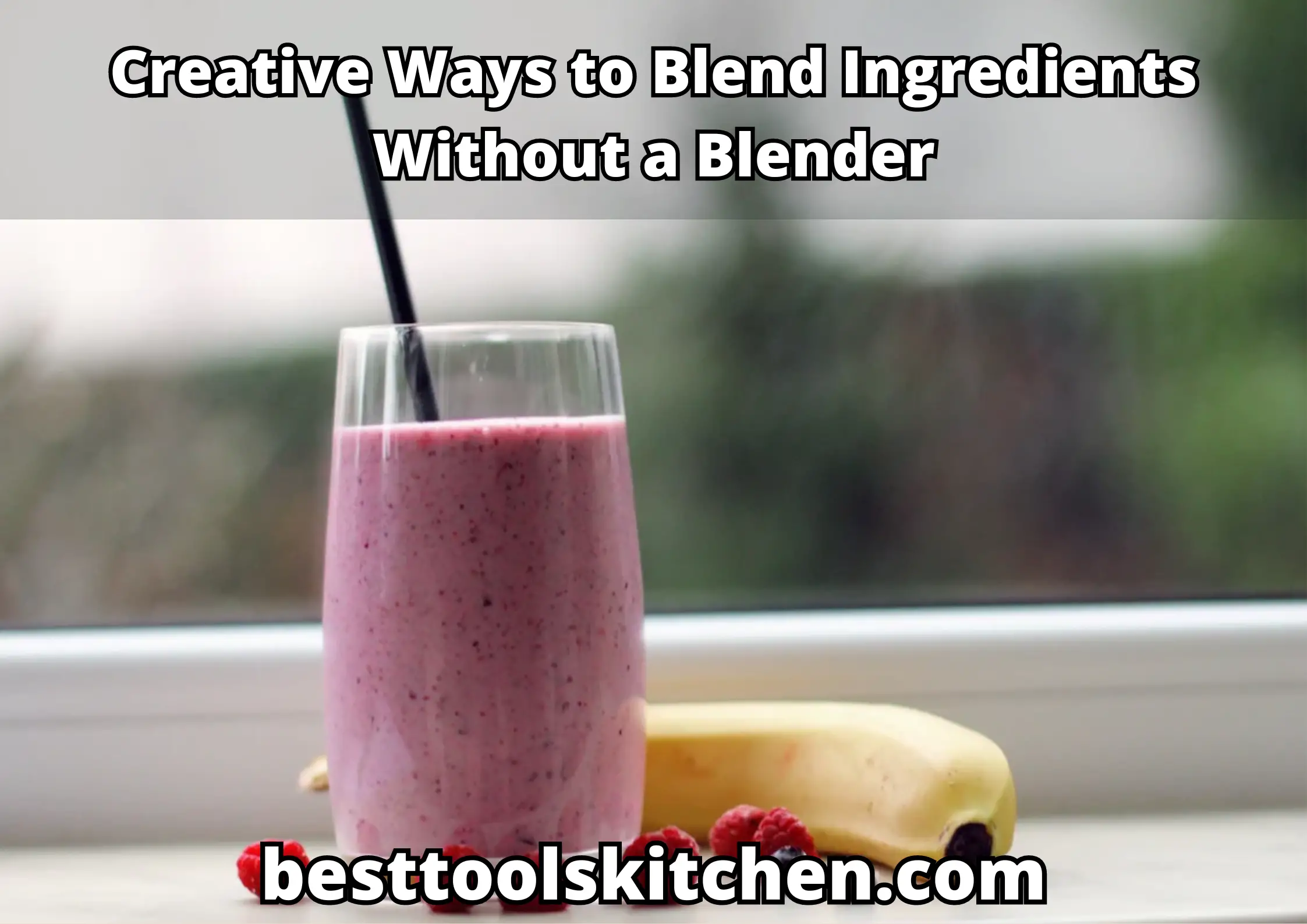Embarking on a culinary journey often requires more than just traditional tools; it demands a touch of innovation and resourcefulness. In this guide, we reveal ways how to blend without a blender, exploring creative techniques that elevate your kitchen prowess beyond the boundaries of traditional appliances.
Understanding the Need for Blender-Free Blending
In our culinary adventures, the reliance on traditional blenders often limits our flexibility in creating delicious blends. Embracing blender-free blending isn’t just a workaround; it’s a creative invitation to explore alternative methods that tap into age-old techniques and everyday kitchen tools. It’s a doorway to resourcefulness, sparking ingenuity as we reimagine the way we meld flavors and textures without the typical appliance reliance.
Overview of Alternative Blending Methods

As someone deeply immersed in culinary experimentation, my journey into alternative blending methods has been nothing short of revelatory. These methods, often overlooked in favor of conventional blenders, form an intricate tapestry of techniques that carry the essence of both tradition and innovation. I’ve found solace and precision in the timeless ritual of using a mortar and pestle—a connection to the past that allows for a level of control and finesse unmatched by automated devices.
My exploration doesn’t end with manual techniques; it extends to a treasure trove of unconventional kitchen tools that have become my secret weapons in the absence of a blender. Immersion blenders may steal the limelight, but my trusty food processor and hand mixer have proven their mettle time and again, seamlessly stepping in for traditional blending tasks.
And then there are the ingenious alternatives—the ziplock bags, jars repurposed for blending, and even graters—which have sparked moments of culinary ingenuity in my kitchen.
Through my experiences, I’ve come to see this landscape of alternative blending not as a compromise but as an expansive playground where tradition and innovation converge, offering endless possibilities for crafting flavors and textures in ways I never imagined.
How to blend without a blender – Manual Techniques
Using a Mortar and Pestle

Using a mortar and pestle has become an irreplaceable part of my culinary journey, weaving a thread of tradition and artistry into my kitchen rituals. There’s something almost meditative about the process—the deliberate grinding, the rhythmic pounding—that connects me deeply to the essence of every spice and herb. It’s not just about creating blends; it’s a tactile experience where I’m in complete control, coaxing out flavors and textures with each movement.
This ancient tool isn’t just about practicality; it’s about infusing dishes with authenticity and a unique depth. From crafting personalized spice mixes to pounding fresh herbs for pestos, the mortar and pestle offers a level of customization that resonates with every dish.
The mortar and pestle isn’t just a kitchen gadget; it’s a companion that honors tradition, adds a touch of craftsmanship to my cooking, and elevates every meal with a touch of heritage.
Whisking and Stirring for Blending

Whisking and stirring might seem like simple actions, but in the realm of blending without a blender, they’re my secret weapons for achieving remarkable textures and flavors. From emulsifying vinaigrettes to whipping up fluffy eggs, the whisk becomes an extension of my hand, allowing me to craft textures that embody precision and subtlety.
Similarly, stirring takes on a different guise—it’s about coaxing ingredients gently, allowing them to meld harmoniously without the forcefulness of machinery.
The beauty of whisking and stirring lies in their simplicity and the control they offer over the blending process. It’s not just about combining ingredients; it’s about infusing them with care and intention. In the rhythm of the whisk or the gentle swirl of a spoon, I find a connection to the culinary traditions of the past, where these fundamental actions were the cornerstone of blending.
Mashing and Crushing: Hand Techniques

When it comes to blending without a conventional blender, mashing, and crushing are my go-to hand techniques that wield extraordinary results. There’s a primal satisfaction in using these methods—whether it’s mashing avocados for creamy guacamole or crushing garlic into a fine paste—that machines simply can’t replicate. With the simple pressure of a fork or the back of a spoon, ingredients transform under my hands, creating textures that are both rustic and nuanced.
The beauty of mashing and crushing lies in their versatility. They transcend specific tools, relying instead on the force and finesse of the human touch. From crushing spices to mashing beans for a hearty dip, these techniques honor tradition while embracing adaptability.
Kitchen Tools for Blending
Immersion Blender Alternatives

Exploring immersion blender alternatives has been a journey into the realm of resourceful blending, revealing an array of tools that step in admirably when the immersion blender isn’t at hand. One trusty substitute I’ve come to rely on is the traditional whisk.
Its versatility and ability to aerate ingredients make it an excellent alternative, especially for lighter tasks like blending eggs for omelets or whipping cream to soft peaks. The whisk’s agility allows me to control the blending process, achieving the desired consistency with precision.
Another unsung hero in the absence of an immersion blender is the food processor. Its power and capacity to handle a variety of blending tasks, from pureeing vegetables for soups to making nut butters, make it a worthy contender. The pulsing action of a food processor mimics the blending motion, resulting in finely blended mixtures and creamy textures. Its multiple attachments and variable speeds offer adaptability, allowing me to tackle diverse blending needs with ease.
Exploring these immersion blender alternatives has taught me the art of adaptability in the kitchen. While the immersion blender is undoubtedly convenient, these alternatives have proven their mettle, showcasing that efficient blending can be achieved with a touch of creativity and the right tools at hand.
Food Processor Substitutes
Let’s explore some alternatives to a food processor:
- Mortar and Pestle:
Embracing the artisanal approach, a mortar and pestle can be an unexpected yet effective substitute for a food processor. This age-old tool allows for controlled grinding and pounding of ingredients, ideal for tasks like crushing spices, creating herb pastes, or blending small quantities of ingredients.
While it might require a bit more effort and time, the mortar and pestle offer a hands-on experience, enabling a deeper connection with the ingredients and producing blends with distinct textures and flavors. - Hand Chopper or Manual Food Processor:
A hand chopper or manual food processor serves as a practical substitute for larger electric food processors. These handheld devices employ manual chopping and blending mechanisms, making them suitable for tasks like chopping vegetables, mincing herbs, or even blending smaller batches of ingredients.
While they may not offer the same capacity or power as electric food processors, their compact size and portability make them handy alternatives, especially for smaller blending needs or when kitchen space is limited.
Creative Solutions
Blending with Ziplock Bags

Blending with ziplock bags has been a game-changer in my kitchen, especially when traditional blending tools aren’t on hand. Here’s a step-by-step guide based on my experience:
Preparation: Gather your ingredients and a sturdy, food-grade ziplock bag. Ensure the bag is of good quality to withstand the blending process without tearing.
Ingredients Inside the Bag: Place the ingredients into the ziplock bag, making sure not to overfill it. Remove excess air before sealing the bag tightly to prevent leaks.
Seal Securely: Double-check the seal to ensure it’s airtight. This step is crucial to prevent any spills or leaks while blending.
Begin Blending: Lay the bag flat on a stable surface and start blending. Depending on the ingredients, use your hands to gently knead, squish, or press the bag to combine the ingredients thoroughly.
Observe and Adjust: Keep an eye on the contents through the transparent bag. Adjust your blending technique as needed to ensure all ingredients are adequately mixed.
Completion and Cleanup: Once you’re satisfied with the blending, carefully open the bag and use the contents as required in your recipe. Dispose of the ziplock bag responsibly.
This method has proven particularly handy for tasks like combining marinades for meats or fish, mixing dry rubs, or even preparing ingredients for coatings or batters. While it might not achieve the same consistency as traditional blending methods, it’s a fantastic makeshift solution that gets the job done efficiently. Plus, the lack of extra cleanup is a bonus—simply dispose of the bag once you’re done.
Jar and Bottle Blending Techniques

Blending techniques using jars and bottles present a clever and accessible way to mix ingredients without traditional blenders. Here’s a guide based on my experience:
Selection of Containers: Opt for glass jars or bottles with tight-sealing lids to ensure they can withstand the blending process without leaking or breaking. Mason jars or sturdy bottles with secure caps work well.
Ingredient Placement: Place the ingredients inside the jar or bottle, ensuring it’s not filled beyond its capacity. Leave some room to allow for movement during blending.
Seal Securely: Close the lid tightly to prevent any spills during the blending process. Double-check the seal to avoid any mishaps.
Blending Technique: Hold the sealed container firmly and begin blending. Shake, rotate, or swirl the container vigorously to blend the ingredients thoroughly. This motion helps simulate the blending action, combining the contents effectively.
Observation and Adjustments: Periodically check the progress by examining the mixture through the container’s transparent surface. Adjust the blending technique as necessary to ensure all ingredients are well incorporated.
Completion and Usage: Once satisfied with the blending, open the container and use the contents as needed for your recipe. Clean the container for future use or recycling.
This method is particularly useful for combining salad dressings, mixing marinades, or creating simple sauces and vinaigrettes.
Creative Uses of Graters and Sieves
Let’s explore the creative applications of graters and sieves in the kitchen:
Graters
:max_bytes(150000):strip_icc()/7-best-graters-of-2022-test-main-56fdaf0fed0a4ba3813f87243e32b0a5.jpg)
Graters, known for their typical use in shredding or grating foods, have versatile applications beyond their conventional role. When it comes to blending, they can be employed to create fine textures or blends by using ingredients that are suitable for grating.
For instance, hard cheeses, vegetables like carrots or zucchini, and even frozen butter for pastry dough can be finely grated. These grated ingredients can then be incorporated into mixtures, batters, or sauces, adding a unique texture and flavor profile.
Sieves
Having navigated the culinary terrain, I’ve discovered that sieves, usually reserved for sifting and straining, unfold as unexpected heroes in blending. Soft or delicate ingredients find their match as the sieve effectively coaxes them through, ensuring a blend that’s silky-smooth.
Whether sieving cooked vegetables to bid farewell to fibers or coaxing soft fruits through its mesh for a lush puree, my culinary ventures have taught me to appreciate the adaptability of sieves in crafting consistently well-blended results.
Tips and Tricks
Tips for Achieving Consistency

Achieving consistent blends has been a game of technique and patience in my culinary journey. Here are the tips I’ve learned along the way:
- Preparation Precision: Before blending, ensuring all ingredients are uniformly chopped or sliced makes a world of difference. Consistent sizes mean they’ll blend evenly, resulting in a smoother mixture.
- Layering Strategy: When using manual methods or alternative tools, the layering of ingredients matters. Starting with the softer or smaller items at the base facilitates a smoother blending process.
- Pulse and Pause Mastery: With appliances like food processors, the pulse setting is your friend. Pulsing in short bursts and pausing to scrape down the sides helps ensure a consistent blend without overworking the mixture.
- Controlled Blending: Handheld tools demand a steady hand. Gradual blending motions and controlling the intensity of blending often yield the best results in achieving consistency.
- Time and Tender Care: Patience truly pays off. Allowing enough time for blending, especially with manual methods, ensures a more uniform blend without rushing the process.
- Playing with Speed: Adjustable-speed blending tools allow for experimentation. Trying different speeds might just be the trick to achieving that perfect consistency.
- Frequent Checks: Regularly assessing the blend’s texture during the process helps. Adjusting blending time or techniques based on the texture you’re aiming for ensures a smoother outcome.
- Temperature Tricks: Being mindful of ingredient temperatures matters. Some ingredients blend better when slightly chilled or at room temperature, impacting the final consistency.
- Capacity Awareness: Whether it’s using unconventional containers or methods like ziplock bags, being mindful of the fill level prevents messy spills and ensures thorough blending.
- Matching Techniques to Ingredients: Different ingredients call for different approaches. Some require gentle blending, while others might need a more vigorous hand to achieve the desired consistency.
Safety Precautions and Best Practices

Safety in the kitchen, especially when blending without traditional equipment, is crucial. Here are some key safety precautions and best practices:
- Mindful Handling: When using manual methods or alternative tools, be mindful of your hand placement and movement. Avoid placing hands too close to blades or moving parts to prevent accidents.
- Careful Start-Up: With electrical appliances or hand tools, be cautious when starting or stopping them. Always start at lower speeds to prevent splattering or sudden movements.
- Avoid Overloading: Do not overload manual tools or improvised containers beyond their capacity. Overloading might lead to strain or breakage, posing safety hazards.
- Blade Awareness: Exercise caution when handling blades, especially when cleaning or assembling/disassembling tools. Use protective gear like gloves if necessary to prevent accidental cuts or injuries.
- Cooling Down Ingredients: Allow hot ingredients to cool down before blending to prevent steam pressure buildup in sealed containers, reducing the risk of burns or spills.
- Read Manuals and Instructions: If using electrical appliances or tools, familiarize yourself with their manuals and operating instructions. Follow manufacturer guidelines for safe usage and maintenance.
- Cleaning and Maintenance: Regularly clean and maintain tools to ensure their proper functioning. Unplug electrical appliances before cleaning to avoid electric shock hazards.
- Children and Pets: Keep children and pets away from the blending area to prevent accidental injuries. Store tools safely out of their reach when not in use.
Conclusion
In exploring the art of blending without a traditional blender, we’ve unlocked a world of culinary creativity and resourcefulness. From using simple tools like mortar and pestle to improvising with ziplock bags and jars, this guide has unveiled a spectrum of inventive techniques.
Embracing manual methods, alternative tools, and thoughtful blending strategies has empowered us to craft smooth textures, blend flavors, and achieve consistent results without relying on conventional appliances.
FAQ
Can I use a coffee grinder as a substitute for a blender?
While a coffee grinder shares similarities with a blender, it’s best suited for grinding coffee beans and certain spices. Using it for wet ingredients or larger volumes may damage the grinder and affect its performance. For blending purposes, consider alternatives like a mortar and pestle or food processor, which offer better versatility.
Can I blend hot ingredients using alternative methods?
Blending hot ingredients without a blender is possible but requires caution. Allow hot ingredients to cool slightly before blending to prevent steam buildup, which can cause pressure in sealed containers. Manual blending tools like whisks or hand mixers can manage warm ingredients better than some improvised tools or containers.
How can I blend frozen ingredients without a blender?
Blending frozen ingredients without a blender is challenging but feasible. Allow frozen items to thaw slightly to soften before attempting to blend them. Alternatively, use a mortar and pestle for crushing or a sturdy ziplock bag and rolling pin for breaking down frozen components.
Can I make nut butter without a blender or food processor?
Crafting nut butter without a blender or food processor is challenging but possible. Use a mortar and pestle to grind nuts into a coarse paste. Alternatively, consider using a sturdy ziplock bag and rolling pin for a similar effect, though achieving a smooth consistency might be more difficult.
